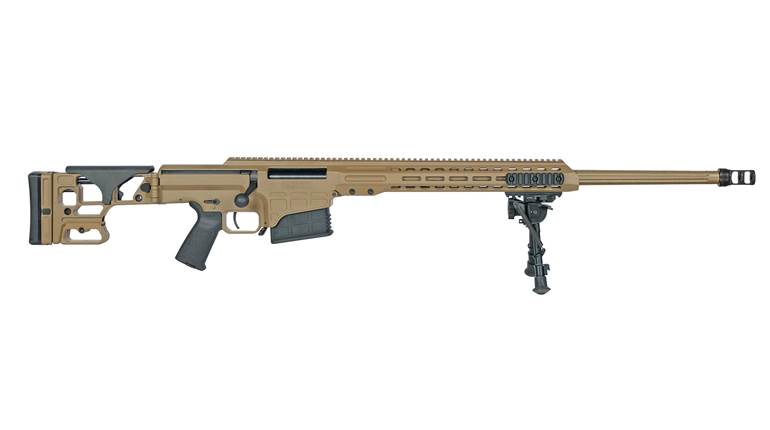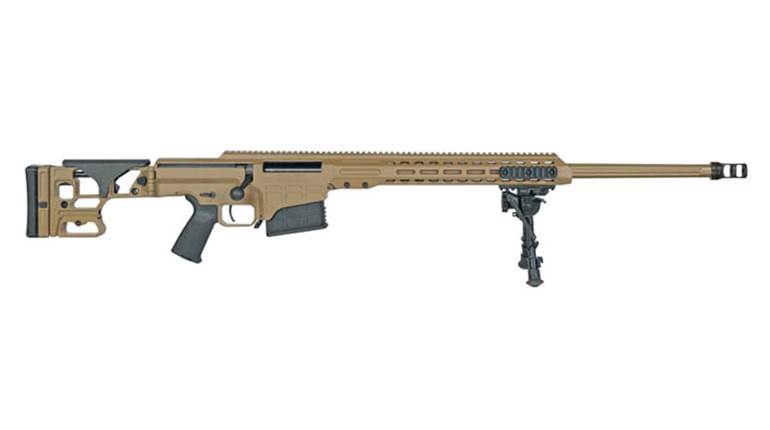
Mention the name Barrett to almost any shooter, and immediately the iconic image of the big semi-automatic .50 caliber comes to mind. And rightly so. The “Light Fifty” as it is often called, (as compared to the “Ma Deuce” of Browning fame, which is considerably heavier), has become the go-to, reach-out-and-touch-someone arm of the Iraq and Afghanistan conflicts. The open terrain and long-range sniping duels in those countries have led to some amazing shooting feats.
Chambered in .50 BMG, the Barrett Fifty, also known as the U.S. M82A1 and M107A1, is the brainchild of Ronnie Barrett. Developed in the mid-’80s, the system is now in use by all U.S. military branches and more than 40 foreign countries. It has become so successful that Barrett received the George Chinn Award in 2004, a prestigious annual recognition of individuals who have made significant contributions to the field of small arms, and the NRA Publications Division’s Golden Bullseye Pioneer Award in 2010. In 2005, the U.S. Army recognized the Barrett as one of the Top 10 Greatest Inventions for the soldiers in performing their mission—the first time in history a small arm received the honor.

But the company has not rested on its laurels. With Ronnie Barrett’s children, son Chris and daughter Angela, joining the Murfreesboro, Tenn., company, a variety of new rifle systems have been introduced. The MRAD rifle system, convertible to several different calibers as well as the REC7, Barrett’s entry into the 5.56x45 mm NATO (and 6.8x43 mm SPC) semi-automatic rifle mix shows the company has not been idle. The latest offering is the Barrett Model 98B, an interesting cross between an AR-type receiver and a bolt-action precision rifle, designed by Chris.
From its first iteration in .338 Lapua, the contemporary Model 98B is offered in a large range of variants. Not only caliber, but barrel length, finish and accessories can be selected by the buyer, making the 98B a semi-custom rifle straight from the factory. In Original guise, it is chambered in .338 Lapua Mag., but in Fieldcraft versions it comes in 7 mm Rem. Mag., .300 Win. Mag., .308 Win. and 6.5 Creedmoor. Finally, as the Tactical it is made in .300 Win. Mag. and .308 Win., the latter of which is the subject of this evaluation. The test rifle was fitted with a 16" barrel with right-hand, 1:10" twist. The dual-chamber muzzle brake brought the tube to 17.5", a handy, compact length for many law enforcement applications. The rifle was in a dark finish called Tungsten Grey, but four other colors are also available.


The bolt system is totally enclosed by the receiver, and smooth function is aided by a pair of Teflon-infused, glass-filled polymer guides—one of which also acts as a dust cover. Three sets of three locking lugs hold the bolt into corresponding recesses in the barrel. It cocks on opening, and the generous handle offers plenty to hold onto when working the action. Bolt lift is about 60 degrees, which allows plenty of clearance between the hand operating it and the optics mounted on the 18" of Picatinny (M1913) rail atop the receiver. The rail itself is made in two pieces and features 20 m.o.a. of built-in rise toward the rear to aid in long-range shooting. The forward section, over the handguard, is long enough to accommodate any night sight device in front of the scope. The handguard, one piece with the upper receiver, has multiple spots for additional accessories. The scope in this case was the wonderful Leupold Mark 4 LR/T. It is a 4-14X 50 mm model with mil-dot reticle. Heavy duty Barrett rings held it in place.
The non-adjustable buttstock is part of the lower receiver and has a soft rubber butt pad made of Sorbothane. That, and the weight of the rifle (12 lbs., 12 ozs. with scope) made recoil a non-issue. The entire design of the rifle is straight-line, very streamlined. There is an adjustable cheekpiece but I only had to raise it a quarter-inch due to the low-mounted scope. A comfortable pistol grip and 10-round-capacity polymer magazine in front of the trigger guard contributed to its AR-style appearance. But the generous bolt handle gives it away. The pistol grip could be replaced by any designed for an AR-15/M16/M4 but was so comfortable that I didn’t feel the need to do so. A short section of Picatinny rail integrated into the buttstock serves as a mounting point for an included, height-adjustable monopod. The two-position safety works like that of an AR, is reversible and also acts as the retainer for the trigger assembly.
A study of the manual for this rifle shows the trigger is adjustable for weight, sear engagement and overtravel. It was easy to remove from the receiver by moving the safety lever to its mid-point and tapping it out. Of particular interest, the manual provides instruction for returning the trigger adjustments to factory specifications. The trigger on my sample broke at slightly more than 2 lbs. The pull was crisp but later, after firing a large number of rounds, it developed an occasional, very slight creep. I pulled the trigger assembly from the lower receiver, cleaned the exposed surfaces and re-installed it. I experienced no further problems with the trigger pull. In fact, I was very impressed with its let off, and there was virtually no overtravel.
Disassembly was easy. Press in on the receiver latch, located directly behind the trigger guard, and move the rear of the upper receiver away from the lower, as with an AR. The bolt assembly and bolt guides can be removed by sliding them to the rear. The upper and lower receivers can be separated by pushing out the front assembly pin. If needed, the trigger assembly can be detached by removing the safety and sliding the unit to the rear and out. It is very straightforward in operation. The bolt assembly can be taken down following the detailed instructions in the manual. Reassembly is in the reverse order.
The rifle was tested using a variety of match-grade ammunition—mostly with 168-gr. loads although one used 175-gr. bullets. Groups with all five loads were around one inch at 100 yds. when shooting off the bench. During the firing of several hundred rounds, I found the bolt throw to be longer than I thought necessary. The bolt had to be drawn rearward about an inch after clearing the base of the next cartridge. This put the hand close to or touching the shooter’s face during a reload. I measured the bolt throw at its various functions. From a closed bolt position, the empty cartridge case was ejected as soon as the case mouth cleared the port, at about 2.87". Continuing the rear movement of the bolt, the base of the next live cartridge slipped in front of the bolt face at 4.12", but then the bolt could be moved an additional 1.31" to its stop, for a total of 5.45" of bolt throw, necessary for a long-action caliber but not for the short-action .308 Win.
Overall, the operation of the 98B is just what a serious shooter might expect from a rifle wearing the Barrett name. The magazine release was excellent, being centrally positioned just at the front of the trigger guard and within easy reach of the trigger finger, and the magazine snapped into place firmly with little play and functioned perfectly.
My grandson Jay, who is left-handed, assisted me with some of the range work, and I watched as he shot a couple rapid-fire sequences. The enclosed bolt system seemed to help as he worked the bolt with his right hand while he kept his eye on the scope.
All in all, this streamlined 98B is an interesting and welcome continuation of the Barrett line. And a good addition to the “Light Fifty” family.
Manufacturer: Barrett, P.O. Box 1077, Murfreesboro, TN, 37133; (615) 896-2938; barrett.net
Caliber: .338 Lapua Mag., 7 mm Rem. Mag., .300 Win. Mag. and .308 Win. (tested)
Action Type: bolt-action, repeating center-fire rifle
Receiver: aluminum
Finish: anodized, five colors available
Magazine: 10-round-capacity polymer detachable box
Barrel: 16" (tested) to 26", stainless steel, heavy contour, double-chamber muzzle brake
Overall length: 38¾"
Rifling: 1:10" RH twist (tested)
Weight: from 9 lbs., 4 ozs (tested, rifle only) 12 lbs., 12 ozs., (tested, with empty magazine and 4-14X scope) to 13 lbs., 8 ozs. (.338 Lapua Mag. with 26" barrel, rifle only)
Sights: none; Picatinny rail with 20-m.o.a. angle
Trigger: adjustable, single-stage; 2-lb., 2-oz. pull
Stock: integral with lower receiver; Sorbothane butt pad, adjustable cheekpiece
Accessories: quick-connect sling point, owner’s manual (tested); Harris bipod, monopod, extra magazine, accessory rails, Pelican case (.338 Lapua Mag.)
Suggested Retail Price: $3,999 to $4,499; $4,299 (rifle only, tested)







































